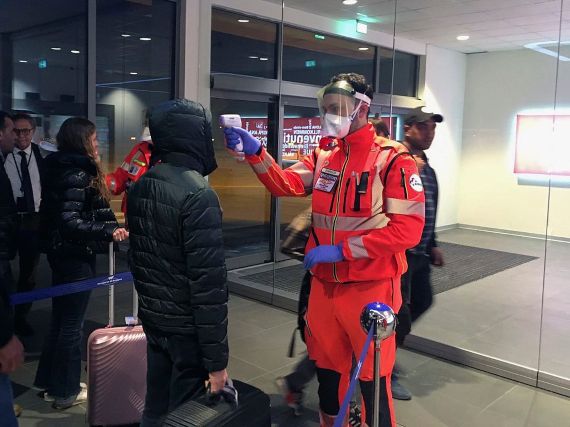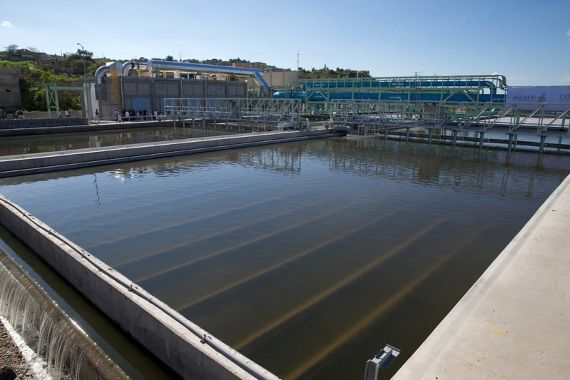In the face of concerns about a second wave of COVID-19, public health authorities are on high alert to be able to react quickly, thereby avoiding another confinement period that could once again cripple the economy. Given the limited diagnostic testing capacity that currently exists, other methods and tools are needed to detect signs of any re-emergence of the virus. The goal is to be able to carry out real-time mass monitoring of the spread of the coronavirus in the population; three non-invasive techniques have emerged for this purpose, using temperature sensors and the analysis of air and wastewater samples.
Hunting the virus in the air
As respiratory viruses are transmitted by droplets —expelled by sneezing, coughing, speaking or breathing— and can remain suspended in the air for some time, a non-invasive method to track SARS-CoV-2 in real time would be to measure the concentration of virus particles floating in the air in highly-frequented locations, such as train stations or hospitals. A team of researchers from the Swiss Federal Laboratories of Materials Science and Technology (EMPA) and the ZTH Research University of Zurich are developing optical biosensors capable of doing just that.

Using a technology called localized surface plasmon resonance (LSPR), the devices employ gold nanostructures embedded with tiny DNA receptors that match unique sequences of the virus’ RNA strand. When coronavirus molecules bind to the receptor, like two pieces of a jigsaw puzzle fitting together, the light modulation of the nanostructures changes, which can be detected by the optical sensor, confirming the presence of the virus. This technique is used in pollution detection devices, but has been modified to identify SARS-CoV-2. The device also contains a laser that is fired into the nanostructures; this increases the ambient temperature, reduces the risk of false negatives and provides a second confirmation that the correct virus has been detected. Tests have shown that the device is able to distinguish between SARS-CoV and SARS-CoV-2 coronaviruses —which are only slightly different— and provide results within minutes.
However, before these devices can be put to use outside the laboratory, researchers need to develop systems to collect the air, filter out the aerosols and extract the RNA from within the viral envelope. At this point, it is not known what effect the ubiquity of face masks will have on the amount of coronavirus present in the air. Nevertheless, once the technology is perfected, it could easily be adapted to detect other viruses and help to bring future epidemics under control more quickly.
Mass fever as a symptom of an outbreak
It is one of the symptoms of COVID-19, although not all those infected have a fever, and not all those with a fever have the virus. In spite of this, the demand for temperature sensors, especially thermal imaging cameras and thermometer guns, has soared in recent weeks across the globe. Airports, hospitals, hotels, shopping malls, transportation warehouses and other high-traffic areas are installing these devices in an attempt to take measures that will serve to ensure public safety. Travelers passing through the Rome-Fiumicino airport will likely see security personnel wearing sophisticated Robocop style helmets (equipped with augmented reality technology and thermal scanners), which allow them to move through crowds and perform temperature scans from a safe distance.

While the deployment of all this high tech may seem impressive at first glance, it is unlikely to provide useful information directly, and may actually do harm by creating a false sense of security. Given the long incubation period of the virus (up to 14 days) during which time many people have no symptoms and yet are infectious, as well as the existence of asymptomatic “silent spreaders“, the absence of fever is no guarantee of a clean bill of health. In addition, medications that reduce fever, whether taken to relieve pain, or by a worker desperate for their paycheque or a traveller concealing their illness during a flight, may render temperature controls ineffective.
A more epidemiologically useful way to utilise body temperature to track the virus is being used by Kinsa, a U.S. company that has sold more than 1.3 million Internet-connected thermometers across the country. According to the company, the data they collect from their thermometer network can be used to identify abnormalities in the number of flu-like illnesses, which correlates with the locations of the outbreaks. Company officials explain that: “Rather than a direct measure of COVID-19, we are providing an early warning system for where COVID-19 outbreaks may be occurring. Our data has flagged illness anomalies on average 14 days before state-reported COVID-19 deaths.” The website provides a regularly updated “US HealthWeather Map” which identifies areas where disease levels are unusually high and also shows trends where levels of disease are changing.
Signs in the sewers
Because SARS-CoV-2 is shed from the body in stool at an early stage of infection (often before symptoms appear), this opens the door to an early warning system to detect outbreaks of COVID-19. A spike in the quantity of viral RNA fragments detected in sewage treatment plants would be a clear indication of an outbreak, giving public health authorities the opportunity to prepare and react before a surge of patients shows up in emergency rooms.

This technique has numerous advantages, in addition to its low cost. The speed with which the wastewater generally moves through the sewer system provides an almost real-time snapshot of the actual viral load in the “sewer community”, and the mixing of the wastewater means that samples show the average level of infection, thereby capturing the large number of asymptomatic but infectious people who would otherwise go undetected. In addition, the analysis of samples can be performed using the PCR technique, already established as a reference method for detecting SARS-CoV-2, which eliminates the need for new technological developments. It may also be feasible to “go up-pipe” from the treatment plant, allowing for more refined screenings of neighbourhoods, for example.
However, while collecting wastewater samples and performing the tests are relatively straightforward, extracting epidemiologically important information from the data, such as the number of people infected in the sewerage system catchment area, is more challenging. Models need to be designed and calibrated and standardized data shared with researchers in other regions. This task is made more difficult by the unique characteristics of communities and their sewage systems, along with the lack of medical data linking the amount of virus to the severity of the disease.
To move forward on this complex path, one of the largest wastewater screening programs for SARS-CoV-2 is being carried out in the Community of Valencia (Spain) —with a population of five million— which will involve the collection of samples twice a week from 250 wastewater treatment plants. The USA, Italy, China, the Netherlands, Switzerland, France and Australia have found traces of the virus in their wastewater and surveillance programmes are already underway in these and other countries.
Neil Larsen
Comments on this publication